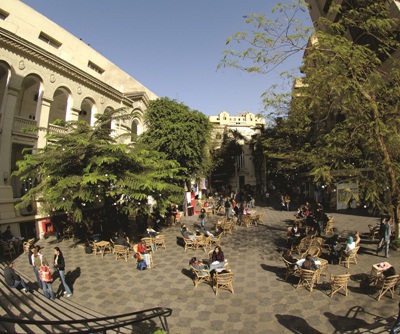By Sarah Topol
Following the university’s move to its campus in New Cairo, AUC’s campus in Tahrir Square continues to serve as a landmark in the heart of downtown Cairo. The campus, which includes the palace, Hill House and Falaki, has been remodeled and renovated to create AUC Downtown.
| |
 |
| |
Photo by Dana Smillie |
Historic Palace
The palace, which constituted the administration building of the Main Campus, was built in the 1860s for the Minister of Education Khairy Pasha. The structure is fashioned in neo-Mamluk style and has been designated a historical monument by the Egyptian Supreme Council of Antiquities, which made remodeling the property a great challenge. “A consultant from the Supreme Council of Antiquities approved every alteration following internationally recognized conservation standards to ensure the preservation of the historic space,” said Hesham Abdel Aziz, associate vice president of AUC Downtown.
In November 2009, a downtown Cultural Center opened in the palace, which now includes a new bookstore, the Margo Veillon gallery and two permanent exhibition spaces. Ewart and Oriental halls continue to host lectures and public events held by the university, and may be rented for outside events.
 |
|
The new, two-story bookstore has
been designed by noted architect Agnieszka
Dobrowolska; photo by Ahmad El-Nemr |
|
The New bookstore, which was designed by noted architect Agnieszka Dobrowolska, displays some of the best offerings from AUC Press on two expansive floors with an open face to Sheikh Rihan Street. It also includes a café, opening out onto a garden, as well as terraces and fountains. Inside the bookstore, one can find an extensive Arabic literature in translation section; scholarly works in Middle Eastern studies, politics, economics and social theory; as well as classical literature, self-help and children’s books –– more than 20,000 titles. Books can also be purchased on order.
Building a two-story bookstore in one room of the palace was complex. University engineers could not build up due to the designation of the building as historic, so they innovated and dug 1.5 meters down. Due to the age of the structure, drawings of the site were unavailable and unforeseen happenings abounded. “During one of our activities, we found out that underneath the bookstore was an 11,000-kilovolt cable, and we had to cut it. It turned out later that this was a cable feeding the Ministry of Interior,” Abdel Aziz said.

The Margo Veillon
Gallery includes a permanent collection of
100 of Veillon’s masterpieces, as well as
some 5,000 of her watercolors, drawings
and graphics;
Photo by Dana Smillie
The Margo Veillon gallery, in honor of Egyptian painter Margo Veillon, opened on her 96th birthday. The gallery maintains a permanent collection of 100 of Veillon’s masterpieces, as well as some 5,000 of her watercolors, drawings and graphics. The gallery will also present larger retrospective shows focusing on modern Egyptian art.
In addition to the downtown Cultural Center, all offices and meeting rooms in Hill House were turned into classrooms.
Falaki Academic Center
In early 2009, the old Falaki building was torn down and transformed into a landscaped sitting area. The 10-story Falaki Academic Center, built a decade ago, was kept to ensure adequate space for the student population. It houses the School of Continuing Education, which makes up the largest component of AUC Downtown; Management Center; and Engineering and Science Services, all of which cater to 65,000 students each year.

Old Falaki demolished and space now serves as a sitting area; photo by Ahmad El-Nemr
Greek Campus
Purchased by the university from the Greek community in 1964, the Greek Campus was the hub of social activity for students. It housed the library, Social Science Building, Jameel Center and School of Continuing Education (previously known as the Division of Public Services).
Plans are currently underway to sell the Greek Campus as well as the Rare Books and Special Collections Library. Meanwhile, 33 Mohamed Mahmoud Street, which used to house AUC Press, has been sold to an Egyptian joint stock company and a local business.
| |
 |
| |
The Greek Campus will be sold, in addition to the Rare Books and Special Collections Library and 33 Mohamed Mahmoud Street; photo by Ahmad El-Nemr |
The building will be used for administrative purposes. The downtown renovations offer an opportunity to celebrate AUC’s legacy in the downtown community and look forward to its future as a beacon of culture and education in the heart of historic Cairo. The university aims to blend the past with the future by presenting modern cultural programs in historic spaces. “AUC has a rich tradition in education and outreach to the community dating almost to its founding,” said AUC President David D. Arnold. “It is important that AUC retain its presence and continue to be a major contributor to the intellectual and cultural life of downtown Cairo.”
|




